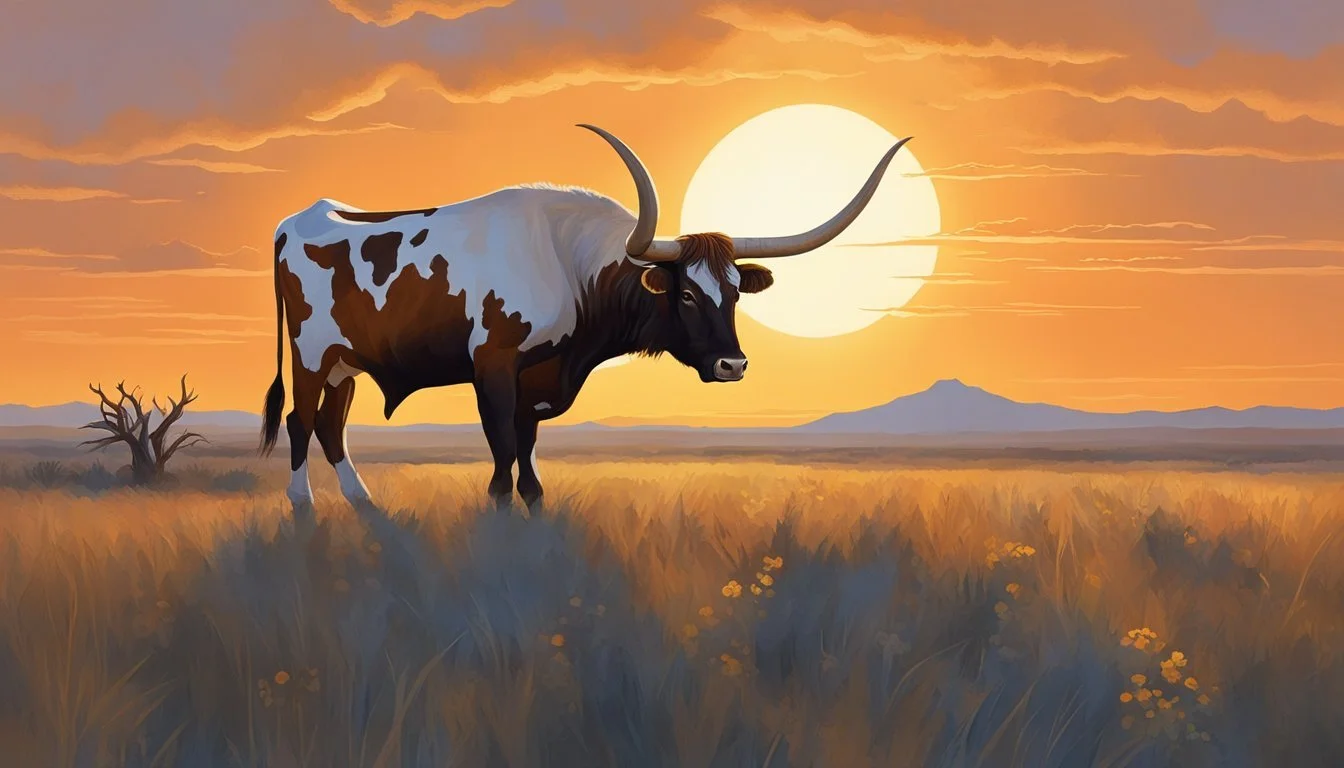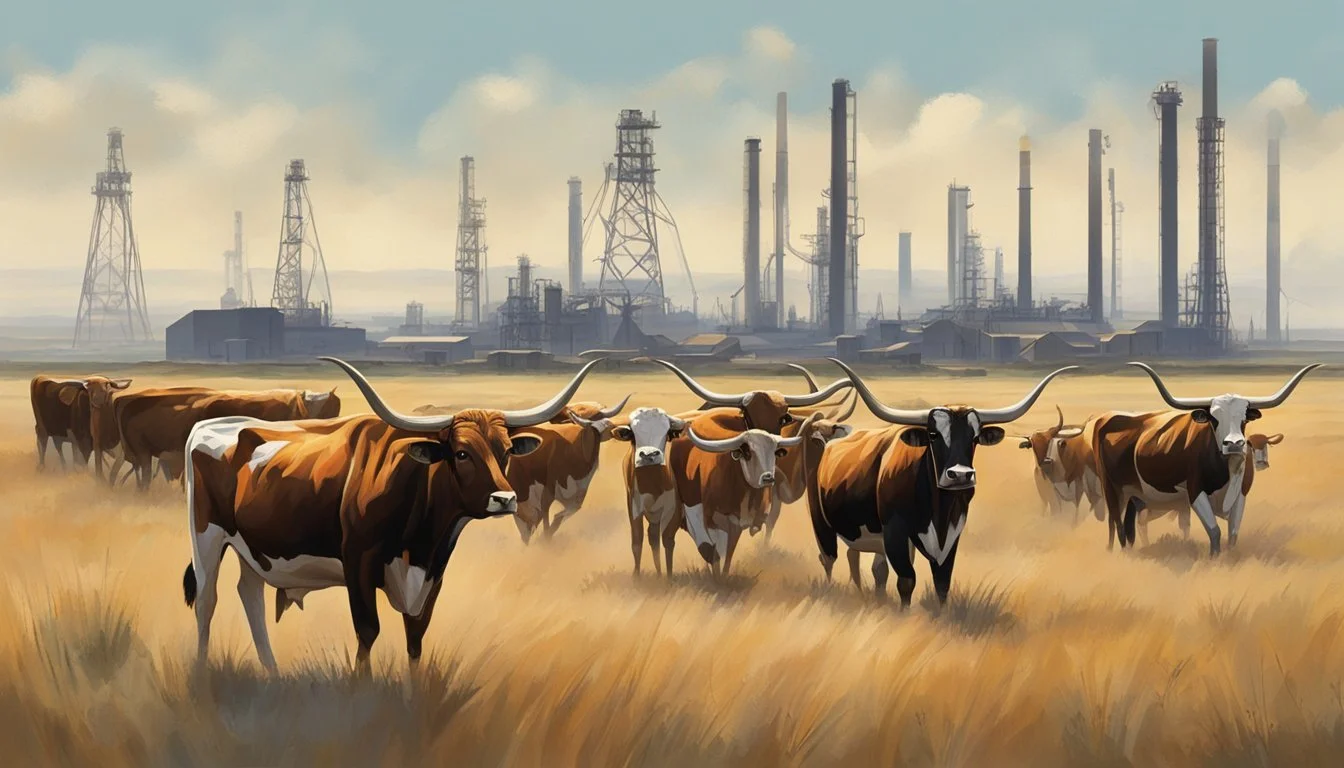The Texas Longhorn
Icon of the American West’s Heritage
The Texas Longhorn is an enduring symbol of cowboy resilience and an emblem of pride for the state of Texas. With its distinctive horns, which can span up to an impressive six feet, the breed is celebrated not only for its contribution to the cattle industry but also for its representation of the unyielding spirit of the American West. The Longhorn's remarkable adaptability to challenging environments echoes the perseverance of the cowboys who drove them on long and arduous cattle drives across the nation.
Rooted in a rich history that dates back to the arrival of Spanish explorers in the Americas in the 1500s, the Longhorn breed is deeply woven into the cultural tapestry of Texas. It stands as a testament to survival and adaptability, having thrived in the harsh landscapes where other breeds could not. This resilience made the Texas Longhorn an icon of the rugged frontier life and a source of state pride that continues to resonate with Texans today.
As a part of the state's identity, the Longhorn has not only shaped the image of the archetypal Texas cowboy but also serves as a symbol of heritage. It represents a connection to the land and the historical significance of the cattle industry in Texas's growth and prosperity. The legacy of the Texas Longhorn continues to inspire admiration and pride, embodying the essence of strength and the spirit of survival that are characteristic of the cowboy way of life.
Historical Significance
The Texas Longhorn is deeply interwoven into the very fabric of Lone Star State history, symbolizing rugged resilience and a quintessential symbol of the Texas spirit.
Origins and Roots
The Texas Longhorn breed emerged as descendants of the Criollo cattle initially brought by Spanish explorers to Mexico and later to the region we know as Texas. This breed is a mix, partly due to English Longhorns brought by early settlers, creating a tough, adaptable bovine ideally suited to the Texan landscape.
Spanish Influence
Spanish influence is deeply ingrained in the development of the Texas Longhorn. It was the vaqueros, the original cowboys, who brought with them from Spain the skills in herding and horsemanship that laid the groundwork for the cattle industry. Their expertise was crucial to managing herds of cattle, including the early Longhorns.
Cattle Drives and Expansion
Cattle drives became a cornerstone of Texas's economy in the late 1800s, with Fort Griffin State Historic Site being one of the starting points. Longhorns were driven north to markets in Kansas, animating cities like San Antonio and trailheads like the Chisholm Trail, expanding Texas's economic and cultural reach.
Civil War Impact
During and after the Civil War, the abundance of Texas Longhorns helped revive the South's economy. Their population had grown substantially during the war when there was little manpower to manage them. Post-war, they were rounded up and sold to other states, representing not just economic asset but also a symbol of survival and hope amidst adversity.
Biology and Breed Characteristics
The Texas Longhorn breed displays a distinct set of physical traits, a rich genetic background contributing to its diversity, and a noteworthy adaptability that has played a significant role in its survival. These characteristics have cemented the Longhorn's status as a resilient and enduring symbol of the American Southwest.
Physical Traits
Texas Longhorns are renowned for their impressive, expansive horns, which can extend up to 7 feet from tip to tip in some individuals. Their coat color is highly variable, often displaying a speckled or patched pattern, encompassing a range from white through roan, to black, brown, and red. The breed's size varies, but bulls typically weigh between 1,000 to 2,000 pounds, while cows weigh 800 to 1,200 pounds, reflecting their hardy, yet manageable stature.
Genetic Diversity
The genetic makeup of Texas Longhorns is a patchwork of historical lineages. Originating from a cross between Spanish and English cattle, they posses a high level of genetic variation. This diversity provides the breed with a robust resistance to disease and resilience against parasites, contributing to the Longhorn's reputation for toughness.
Adaptability
Adaptability is a hallmark of the Texas Longhorn. They are able to thrive on different types of grass and in varied environmental conditions, from arid deserts to lush pastures. This trait likely developed through centuries of facing challenges such as predators, harsh climates, and scarce resources, which shaped them into a symbol of adaptation and perseverance. Their ability to utilize low-quality forage and efficiently convert it into energy is a key aspect of their unique characteristics.
Cultural and Symbolic Role
The Texas Longhorn is an enduring symbol of the state's history and culture. It embodies the rugged spirit of Texas, often associated with the state's identity and marked presence in popular culture.
Texas Identity and Heritage
The Texas Longhorn, with its distinctive horns spanning up to seven feet, is deeply rooted in the Lone Star State's identity. It is a living testament to Texas' rich heritage, symbolizing the resilience and independence of early settlers and cowboys who shaped the region. The longhorns contributed significantly to the culture, being an integral part of the cattle industry that drove the state's economy.
This bovine breed is honored in various Texas state symbols, reinforcing its cultural importance. It shares the stage with the state flower, the bluebonnet; the state tree, the pecan; and even the state fiber and fabric, cotton, as tokens of Texas pride. Beyond mere representation, longhorns are celebrated for their historical role in the state, tied intrinsically to the image of the cowboy and the iconic cowboy hat, representing the unique Texas way of life.
In Popular Culture
Longhorns have transcended their agricultural origins to become icons in popular culture, encompassing music, literature, and sports. They feature in the works of western writers who capture the essence of the region's past and present. The University of Texas at Austin also adopted the Texas Longhorn as its mascot, known as Bevo, symbolizing both athletic tenacity and academic excellence.
Texas Longhorns often appear on screen, in music videos, and at festivals, reinforcing their status as cultural ambassadors of Texas. From their representation on the state flag to being an emblem on apparel and merchandise, longhorns maintain a visible presence that resonates with Texans and admirers of the state's history and values.
Conservation and Current Status
Texas Longhorns have faced challenges from industrialized cattle farming, but dedicated conservationists work to preserve their heritage. Today, they remain symbols of resilience with their numbers occasionally fluctuating, yet herd managers strive to maintain their presence in modern ranching.
Conservation Efforts
Efforts to conserve Texas Longhorns date back to the early 20th century when breeders recognized the genetic and historical value of the breed. Several organizations, such as the Cattlemen's Texas Longhorn Conservancy, focus on ensuring the survival of the breed in its original genetic form. They achieve this by supporting research into the breed's distinct genetics and history, and by educating the public and ranchers on the importance of preserving this unique animal.
Herd Preservation: The state itself maintains a herd to showcase the animal's historical significance.
Breeding Techniques: Breeder associations have implemented careful breeding techniques to ensure the longevity of the Longhorn's distinct genetic traits.
Education & Public Awareness: Increased efforts in public education aim to raise awareness about the need to sustain small herds for genetic diversity and the breed’s historical importance.
Ranching and Herds Today
Despite past declines due to competition with European breeds, Texas Longhorns have retained a niche within modern ranching. They are often celebrated for their hardiness and adaptability, traits that allow them to thrive in wilder pastures where other breeds may struggle.
Herds Size: Ranchers manage both large and small herds across Texas, balancing the demands of commercial ranching with conservation.
Breed Attributes: Texas Longhorns are valued for their longevity and lower maintenance costs, proving beneficial for ranchers seeking sustainable livestock options.
Market Influence: While not the dominant breed, Longhorns have a stable presence in the market, often catering to niche meat products and even ecotourism due to their iconic status.
Economic and Industrial Impact
The Texas Longhorn, linked strongly with the cowboy image, has had a tangible influence on the economy of Texas through its beef industry and the attraction it has become for tourism and educational purposes.
The Beef Industry
The Longhorn cattle breed, once on the brink of extinction, became the cornerstone of a booming beef industry. Initially, Texas ranchers capitalized on the hardiness and adaptability of these cattle to drive economic growth. As ranching intensified, they helped stave off a postwar economic downturn. Texas Longhorn beef, known for its leaner meat compared to other breeds, began to fill the demands of a growing nation hungry for beef. The ranching of Longhorns, which includes the production and sale of meat, has contributed significantly to the state's agricultural revenue.
Tourism and Education
The Longhorn's historical significance is preserved and promoted by entities such as the Texas Parks Board and the Texas Historical Commission. These organizations maintain herds of traditional Texas Longhorn cattle that have become an educational resource and a tourist attraction.
Tours: Visitors can embark on guided tours to learn about the breed and its contribution to Texan heritage.
Texas Parks: Patrons of Texas's state parks can often find Longhorns grazing, serving as living exhibits of the state's past.
Educational Programs: The preservation efforts have also birthed various educational programs aimed at informing the public about the historical value of these unique animals.
By showcasing the Texas Longhorn, these programs not only enrich historical knowledge but also generate economic activity through tourism, creating a sustained interest in the state's ranching roots.
Association with State and National Symbols
The Texas Longhorn stands alongside a host of symbols representing the Lone Star State's unique heritage and natural beauty. These symbols are a blend of natural flora and fauna, historical flags, and emblems of state governance that reflect Texas' diverse landscape and rich history.
Symbols and Iconography
Symbols are powerful emblems of state pride, and Texas has an abundance of them, each symbolizing different aspects of its identity. The Lone Star Flag and the Great Seal of the State of Texas are key patriotic emblems, while natural symbols such as the bluebonnet (Lupinus texensis) and the monarch butterfly celebrate the state's ecological diversity.
State Tree: The Pecan tree.
State Mammals: Besides the Texas Longhorn, the armadillo serves as the state's small mammal, and the Mexican free-tailed bat is the state flying mammal.
State Reptile: The horned lizard.
State Plant: The prickly pear cactus.
State Highway: Texas maintains an extensive highway system that promotes connectivity and commerce.
Each of these symbols contributes to Texas' national identity, appearing on official documents and insignia, including the emblems of historical governance like the Congress of the Republic of Texas. Historical interpretation of these symbols can be explored at venues such as the Bullock Texas State History Museum.
Texas' history under six different sovereign nations—Spain, France, Mexico, the Republic of Texas, the Confederate States of America, and the United States—is referred to as the "Six Flags over Texas," illustrating the state's complex and storied past. The Texas Longhorn embodies this rich tapestry, representing both the challenges faced by early settlers and the resilience of the iconic Texas cowboy.




